Overview
As a parent, recognizing the main symptoms of PDD-NOS is crucial for your child's well-being. These symptoms include:
- Challenges in social interactions
- Communication delays
- Repetitive behaviors
- Sensory sensitivities
- Emotional regulation issues
- Developmental delays
Understanding these signs can be overwhelming, but early identification and intervention can make a significant difference.
Imagine the relief of knowing that, by recognizing these symptoms, you can access timely support that can lead to improved outcomes for your child. This article highlights the importance of acting early, encouraging you to seek help and explore various strategies and therapies that can foster your child's development.
Consider the possibilities that await when you take that first step. With the right support, your child can thrive. We invite you to learn more about the resources available to you and share your experiences with others who may be on a similar journey. Together, we can create a nurturing environment that promotes growth and understanding.
Introduction
Recognizing the signs of Pervasive Developmental Disorder-Not Otherwise Specified (PDD-NOS) in children can feel overwhelming for parents. The intricacies of autism spectrum disorders add to this challenge, making understanding these symptoms all the more vital. Early identification is key; it can lead to timely interventions that significantly enhance a child's development and social integration.
So, what are the essential indicators every parent should be aware of to ensure their child receives the necessary support? This article explores ten crucial symptoms of PDD-NOS, empowering parents with the knowledge to navigate this complex landscape and advocate effectively for their children.
About ASD Media: Empowering Parents with Resources for Autism Awareness
At ASD Media, we are deeply committed to enhancing the implementation of ABA therapy. We understand the challenges you face, and we strive to provide valuable insights and effective strategies that can help improve outcomes for children with autism and ADHD. Our resources are designed for both caregivers and professionals, ensuring that everyone in the community has access to the support they need.
Our mission is to cultivate a supportive and inclusive environment where individuals can share their experiences and learn from one another. We believe that by coming together, we can navigate the complexities of this journey more effectively. By subscribing to our newsletter, you can stay informed about the latest news and gain unlimited digital access to our wealth of resources.
We aim to empower parents and professionals alike, unlocking the potential of children with autism and ADHD. Our effective strategies focus on:
- Managing challenging behaviors
- Navigating support services
- Enhancing interpersonal skills development
Together, we can make a difference in the lives of these children and their families.
Social Interaction Challenges: Recognizing Difficulty in Engaging with Peers
Children exhibiting PDD-NOS symptoms often face significant challenges in engaging with their peers. These difficulties can manifest in various ways, such as:
- Trouble making eye contact
- Misinterpreting interpersonal cues
- Hesitating to initiate conversations
Such interaction deficits can lead to feelings of isolation and frustration, not only for the child but also for their families. Research shows that around 83% of individuals with autism spectrum disorder (ASD), including those with PDD-NOS, experience co-occurring developmental disabilities, which can complicate interpersonal interactions even further.
Recognizing these challenges early is crucial for parents, as taking prompt action can lead to better outcomes. For instance, music therapy has shown promise in enhancing interpersonal skills among youth with ASD, encouraging participation through organized musical experiences. In one study, children who participated in weekly music therapy sessions demonstrated significant improvements in joint attention and communication abilities. This highlights the potential of targeted strategies to foster better peer interactions. As Blythe LaGasse noted, "Music therapy has been suggested as an effective treatment approach for interpersonal interaction, verbal communication, and socioemotional reciprocity."
Statistics reveal that deficits in interpersonal skills are common among children with PDD-NOS symptoms, with many struggling to form and maintain friendships. Developmental psychologists emphasize the importance of addressing these interpersonal challenges, as they can have lasting effects on a young person's self-esteem, academic success, and overall quality of life. The economic burden of raising a child with ASD can range from $1.4 million to $2.4 million over a lifetime, underscoring the need for effective interventions. By recognizing the signs of social interaction challenges, parents can seek appropriate support and resources, paving the way for their children to build meaningful connections with their peers.

Communication Delays: Identifying Delayed Speech and Language Skills
A prominent symptom associated with PDD-NOS symptoms is delayed speech and language skills, which can be a source of concern for many parents. You may notice that your child is not babbling by the expected age or has a vocabulary that seems limited compared to their peers. Research indicates that around 50% of 3-4-year-olds with autism struggle to communicate at a level expected for their age, underscoring the critical importance of early identification and support.
Additionally, many children exhibiting PDD-NOS symptoms may show echolalia, repeating phrases or sentences they've heard without fully grasping their meaning. This behavior is common among individuals with autism and can make communication even more challenging. Recognizing these delays early is vital, as timely intervention can lead to significantly improved outcomes.
Experts emphasize that early speech therapy is crucial for children exhibiting PDD-NOS symptoms. Such therapy not only enhances communication skills but also fosters social interactions and overall development. By addressing these communication challenges promptly, you can help your child navigate the complexities of language acquisition and improve their ability to express thoughts and feelings effectively. Remember, you are not alone in this journey; support and resources are available to guide you and your child towards a brighter future.
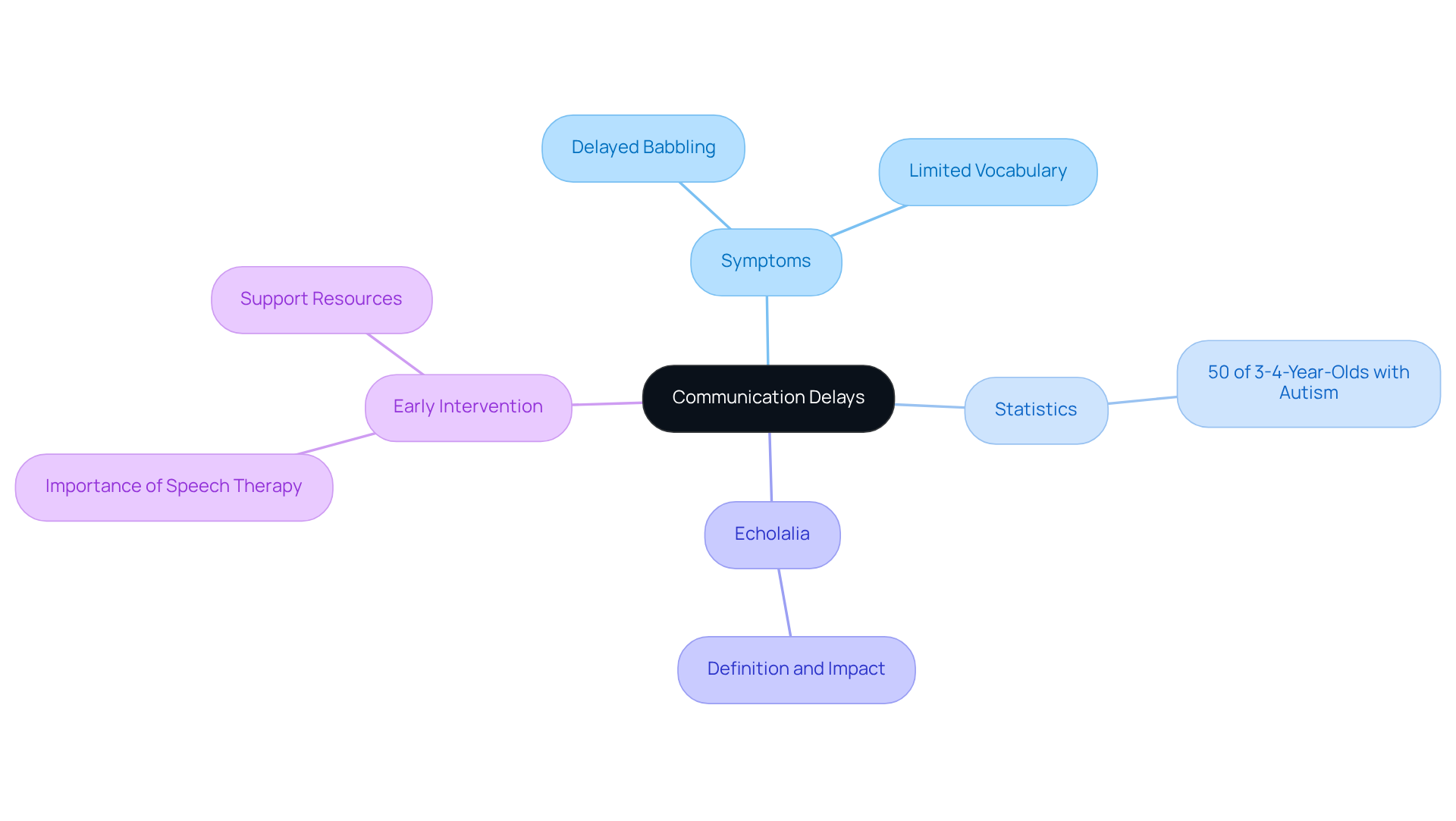
Repetitive Behaviors: Understanding the Importance of Routine and Repetition
Children exhibiting pdd-nos symptoms often engage in repetitive behaviors, such as hand-flapping, rocking, or lining up toys. These actions can serve as coping mechanisms for anxiety or sensory overload, providing comfort in overwhelming situations. For parents, understanding these behaviors is crucial. Behavioral therapists emphasize the importance of establishing a consistent routine, as it nurtures a sense of safety and predictability for these children.
Research shows that routines not only help reduce the frequency of these behaviors but also enhance emotional regulation overall. In fact, around 70% of individuals with ASD experience heightened levels of repetitive behaviors, which can be alleviated through organized routines. Successful routines may include:
- Scheduled activities
- Visual schedules
- Designated quiet times
All contributing to a calmer home environment.
By incorporating these organized routines, guardians can significantly reduce anxiety and foster a more stable daily experience for their children. As highlighted by the American Psychiatric Association, the diagnostic criteria for autism spectrum disorder include pdd-nos symptoms, particularly these repetitive behaviors. This underscores the importance of addressing them through effective routine management, ultimately supporting the well-being of children and their families.

Sensory Sensitivities: Identifying Overreactions to Sensory Input
Children with pdd-nos symptoms often experience significant sensory sensitivities, leading to noticeable overreactions to various stimuli such as sounds, textures, and lights. Imagine a young person becoming visibly distressed by loud noises or refusing to wear certain fabrics due to discomfort. This is a common struggle. Research shows that up to 90% of individuals with autism may exhibit pdd-nos symptoms, such as sensory hypersensitivity, which can result in disruptive behaviors. Recognizing pdd-nos symptoms and other sensitivities is crucial for parents. By understanding their child's experiences, they can make necessary adjustments in their environment, ultimately reducing stress and enhancing comfort.
Occupational therapists emphasize the importance of creating sensory-friendly spaces. Simple changes, like minimizing exposure to overwhelming stimuli and providing calming areas where individuals can retreat when feeling stressed, can make a significant difference. Implementing these strategies not only supports a young person's ability to navigate their surroundings but also helps them engage more comfortably in daily activities. As you consider these insights, think about how you can adapt your home or routines to better support your child. Your efforts can lead to a more harmonious environment, fostering a sense of security and well-being.
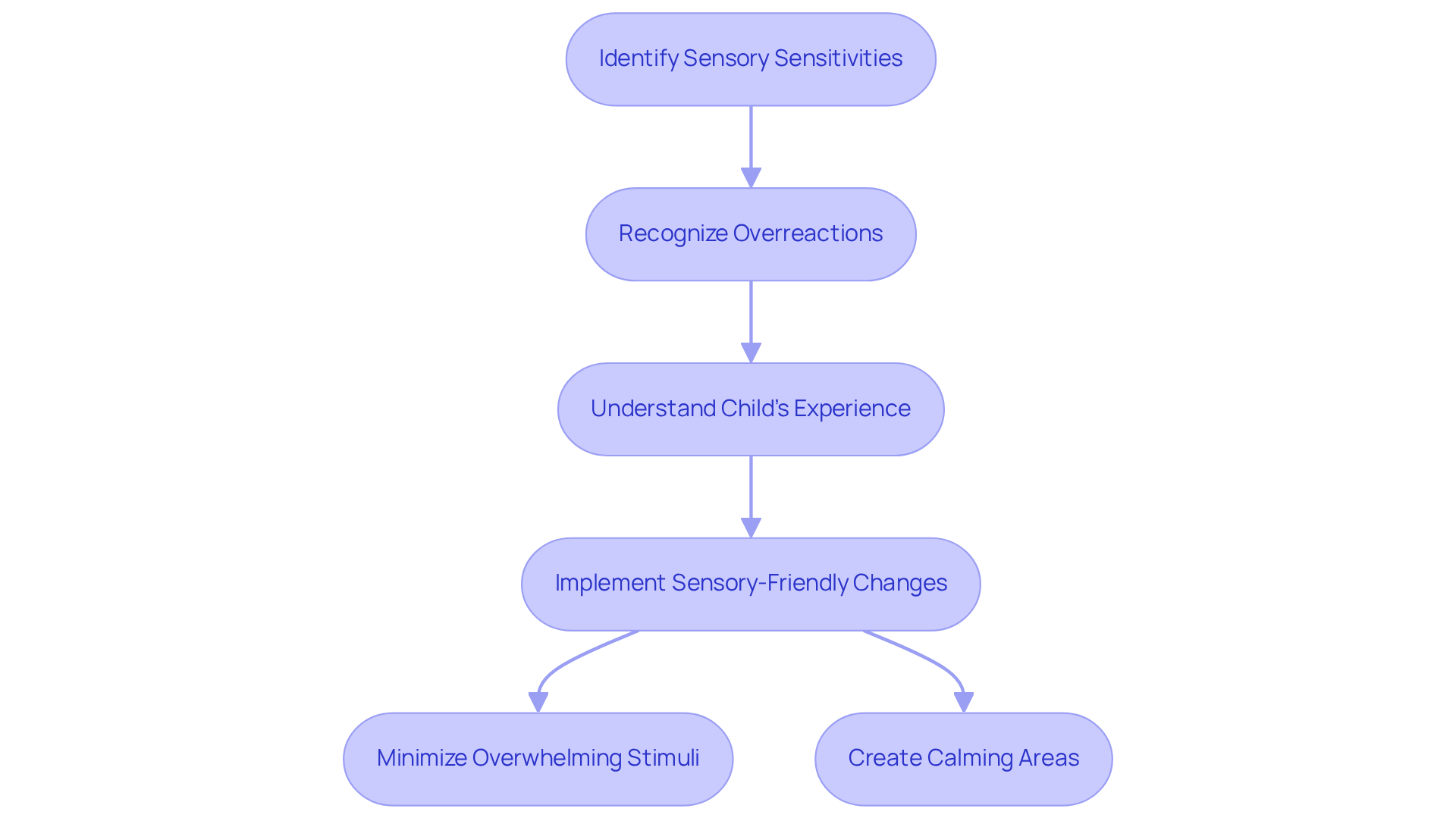
Emotional Regulation Issues: Recognizing Difficulty in Managing Emotions
Children who exhibit pdd-nos symptoms often encounter significant challenges in regulating their emotions. This can lead to outbursts or meltdowns when they feel overwhelmed, a situation that many parents can relate to. Research indicates that emotional dysregulation is a prevalent issue, with studies showing that between 50% and 60% of youth with autism spectrum disorder (ASD) experience these difficulties (Sandy Turner). This struggle often arises from an inability to accurately identify and express emotions, which can result in frustration, behavioral challenges, and pdd-nos symptoms.
To support their children, parents can implement effective coping strategies. Techniques such as:
- Deep breathing exercises
- Mindfulness practices (Baer et al., 2006)
can be particularly beneficial. Visual aids for emotion identification can also play a crucial role in helping children navigate their feelings. Additionally, creating an environment that encourages open dialogue about emotions is vital. This approach not only fosters emotional awareness but also strengthens the parent-child bond.
Experts emphasize that early interventions focusing on emotional regulation can significantly enhance adaptive functioning (Wong et al., 2014). Therefore, it is essential for caregivers to consistently engage in these strategies. By providing resources like emotion charts or mindfulness applications, parents can help mitigate the effects of emotional dysregulation on their children's development. Together, we can create a supportive atmosphere that nurtures emotional growth and resilience.
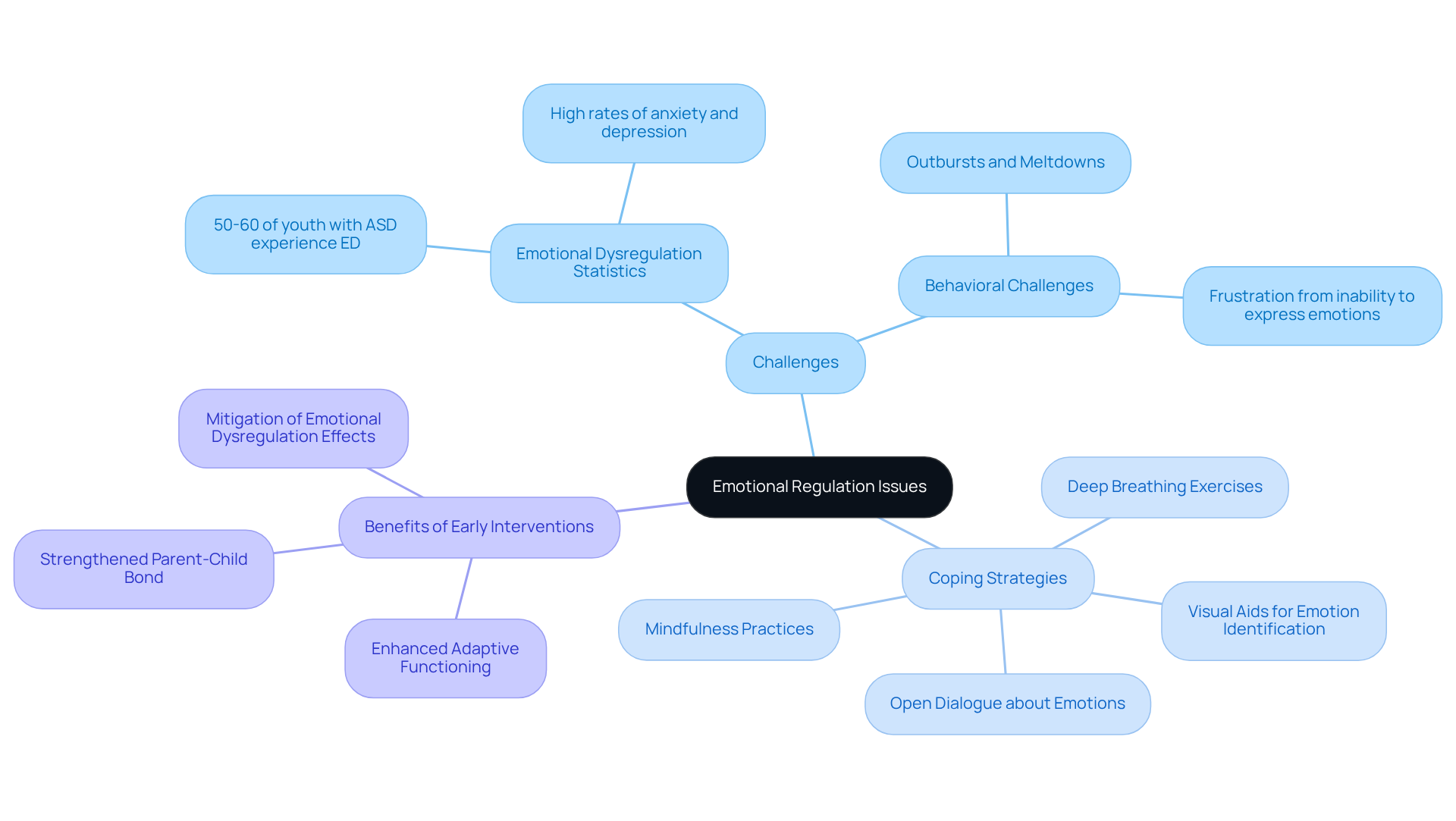
Developmental Delays: Identifying Delays in Milestones and Skills
Developmental delays in youth with pdd-nos symptoms can significantly impact their motor skills, social skills, and cognitive abilities. As parents, you might notice your child struggling to reach essential milestones like walking, talking, or playing with peers, which may be a sign of pdd-nos symptoms. It's important to recognize that approximately 1 in 6 children in the U.S. experiences at least one developmental delay, a trend that has seen the prevalence of any developmental disability rise from 7.40% in 2019 to 8.56% in 2021. Early identification of these delays is crucial, as it opens the door for families to access the therapies and support services they need. Pediatricians emphasize the importance of tracking developmental milestones through routine examinations and milestone checklists, enabling prompt action when necessary.
Effective early support strategies, such as speech and physical therapy, have shown remarkable results, with family-centered early assistance reducing the risk of behavioral issues by up to 45%. Moreover, early intervention can lead to significant improvements in speech and communication skills. By recognizing and addressing developmental delays early, you can help your child achieve better developmental trajectories and enhance their overall quality of life.
It's also essential to consider the socioeconomic factors that may contribute to developmental delays, as these can affect access to vital resources and support. If you find yourself facing these challenges, know that you are not alone. Many families share similar experiences, and there are resources available to help you navigate this journey together.
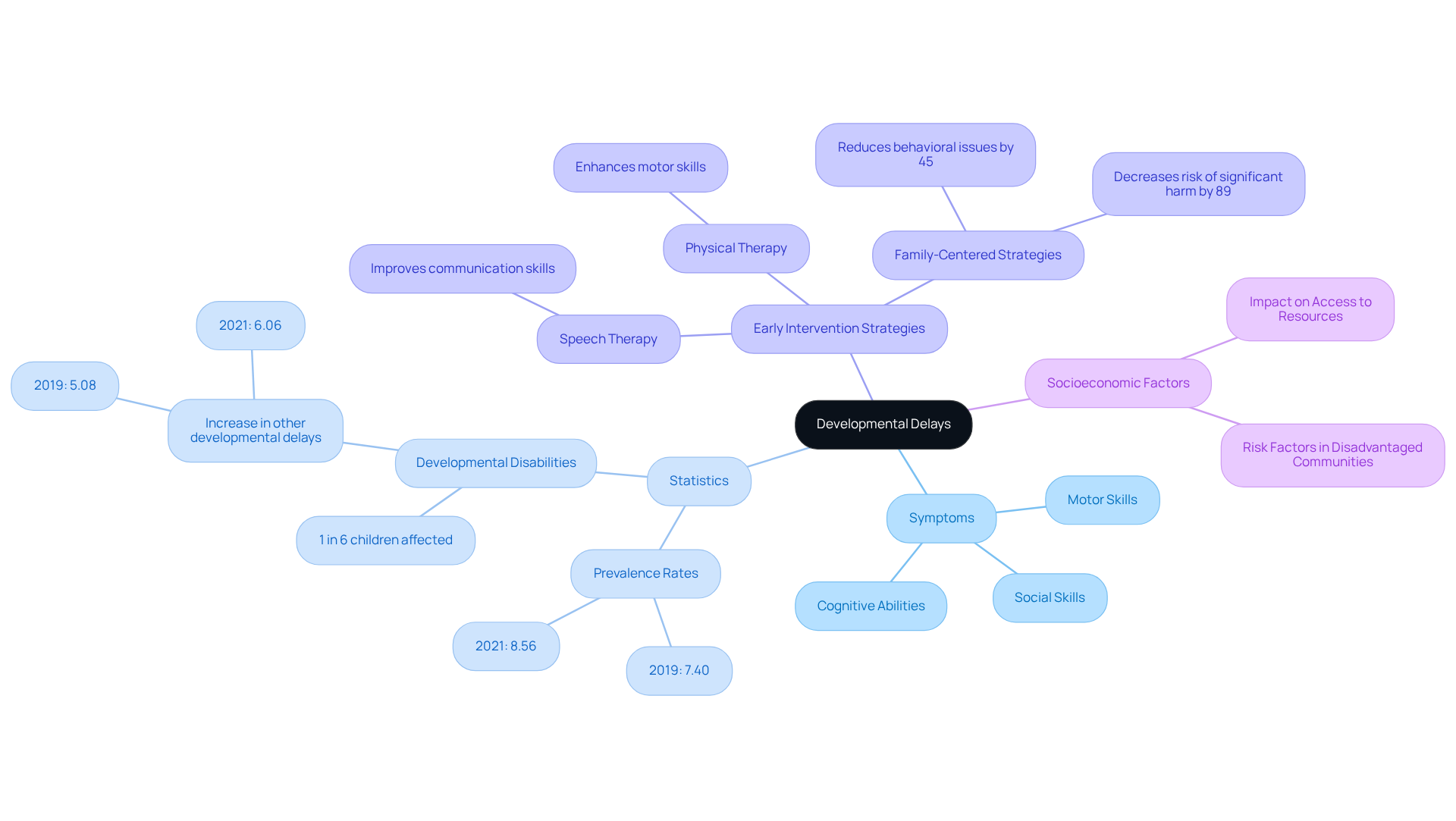
Need for Structure: Recognizing the Importance of Predictable Environments
Children exhibiting PDD-NOS symptoms often flourish in structured environments where routines are predictable. This sense of predictability not only helps to alleviate anxiety but also allows young individuals to feel more secure in their daily lives. As parents, you can create such nurturing environments by establishing consistent daily routines and utilizing visual schedules to clearly outline expectations. By doing so, you foster a sense of stability and support that can greatly benefit your child.
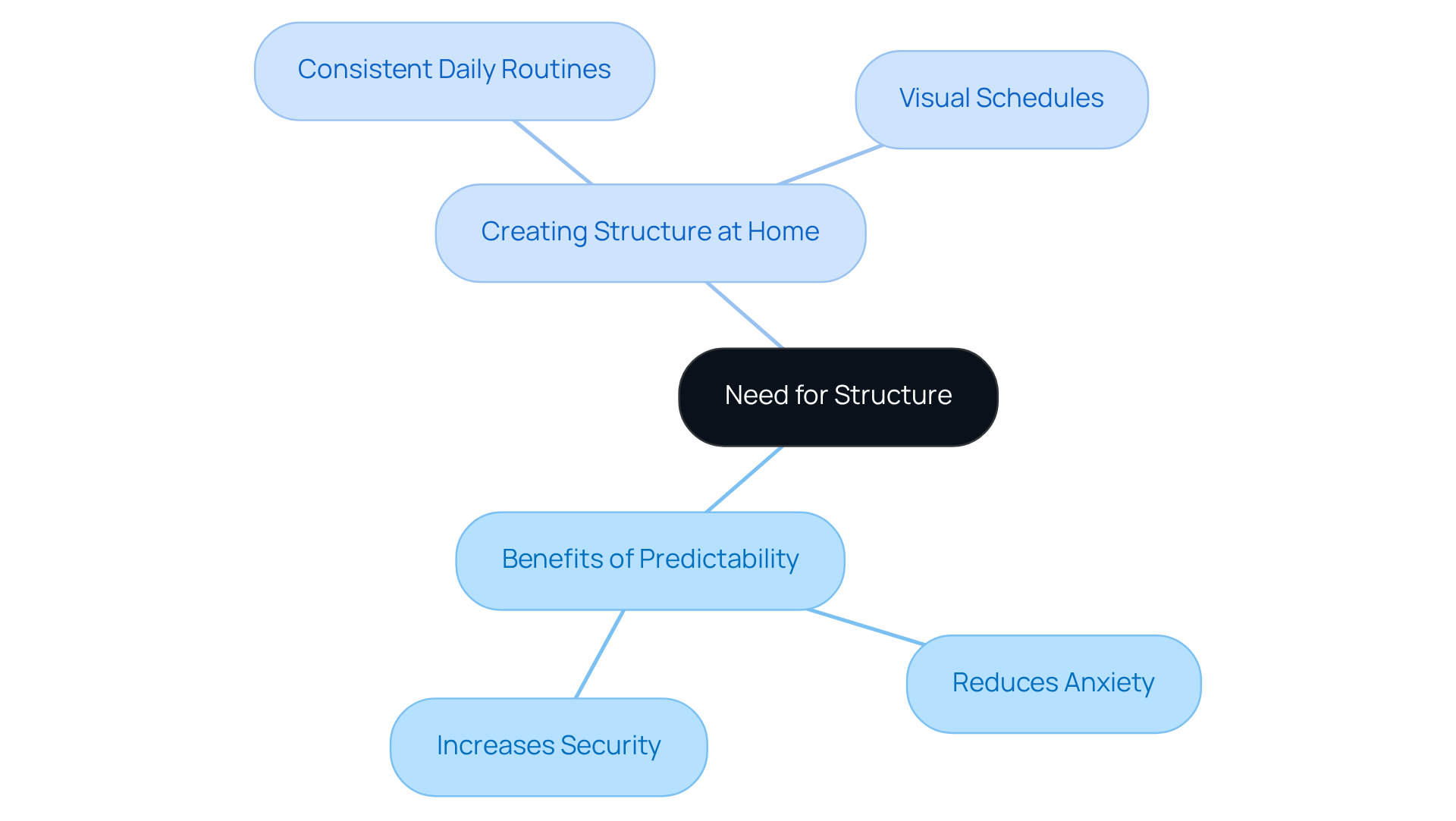
Difficulty with Social Cues: Identifying Challenges in Nonverbal Communication
Children exhibiting PDD-NOS symptoms often face significant challenges in understanding interpersonal cues, such as body language, facial expressions, and tone of voice. Studies indicate that about 40% of children with autism struggle with nonverbal communication, including those exhibiting PDD-NOS symptoms, which can lead to potential misunderstandings during interactions. This difficulty can hinder their ability to connect with peers, often resulting in feelings of isolation and frustration. According to the CDC, individuals with autism frequently encounter obstacles in both verbal and non-verbal communication.
To support their children, parents can:
- Model appropriate interactions, demonstrating how to interpret and respond to nonverbal signals effectively.
- Engage in role-playing activities, which can be particularly beneficial, allowing children to practice recognizing and reacting to various interpersonal cues in a safe environment.
Skills trainers emphasize the importance of:
- Regular practice and reinforcement.
- Structured activities focused on nonverbal communication, which can significantly improve children's interactions.
Insights from interpersonal skills trainers reveal that incorporating games and interactive activities can enhance engagement and facilitate learning.
As we look toward 2025, understanding and addressing these nonverbal communication challenges remains crucial for enhancing the interpersonal skills of youth who exhibit PDD-NOS symptoms. The rising prevalence of autism, with the CDC noting that approximately 1 in 36 children in the United States are diagnosed as of 2023, underscores the need for timely support. By fostering an environment where children can learn and refine these skills, parents can help bridge the gap in their children's social understanding, ultimately leading to more successful interactions with their peers.
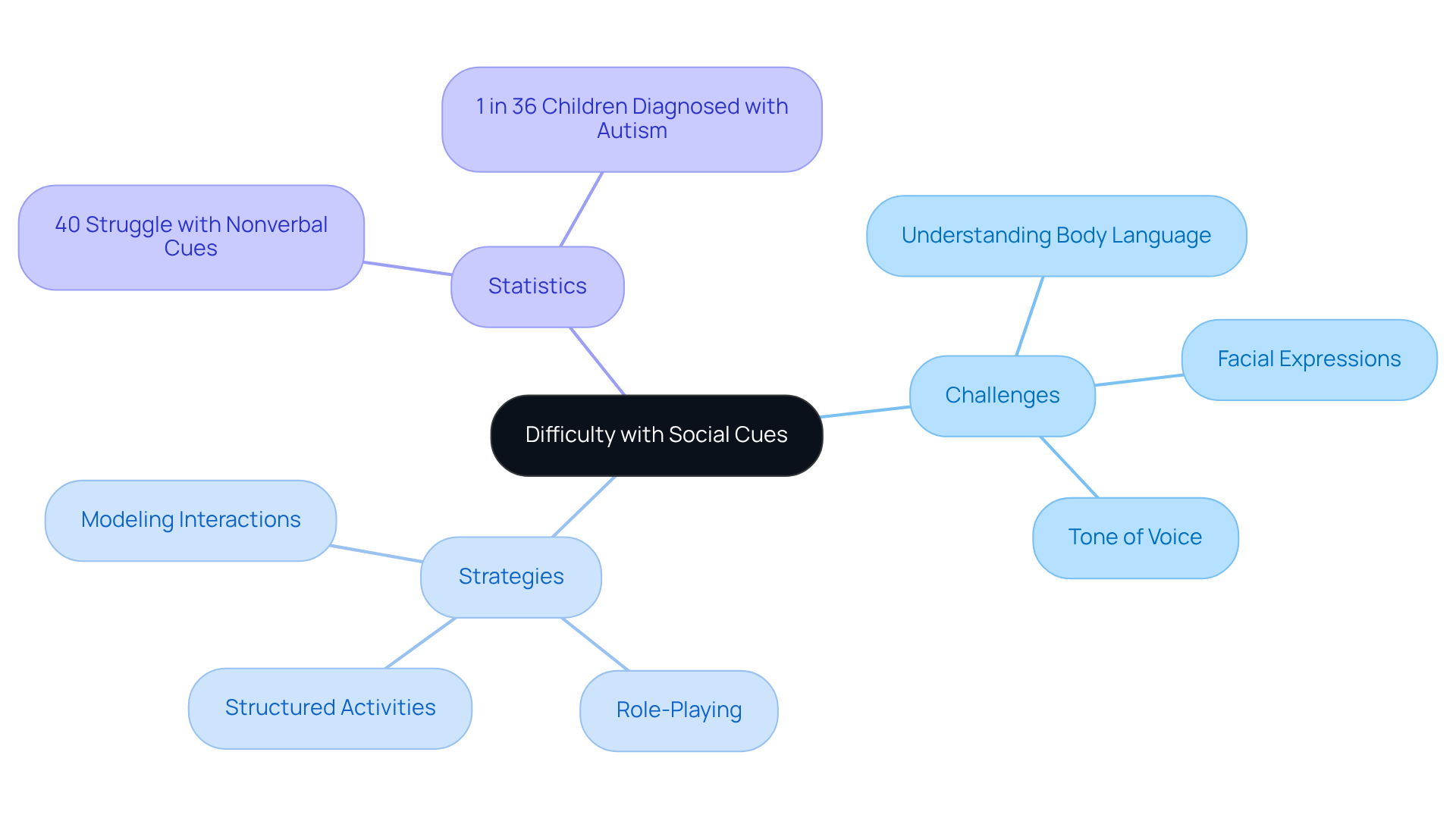
Early Intervention: Recognizing the Need for Timely Support and Resources
Recognizing the indicators of PDD-NOS early on is crucial for parents seeking prompt assistance. This proactive approach can lead to significantly improved developmental outcomes for their children. Early intervention services, such as:
- Speech therapy
- Occupational therapy
- Applied Behavior Analysis (ABA) therapy
play a vital role in helping children acquire essential skills while mitigating the impact of their symptoms.
Experts highlight that early support can lead to a remarkable 60% reduction in challenging behaviors within just six months. This improvement enables children to engage more fully in family and social settings. Moreover, studies reveal that children who begin therapy before the age of three are three times more likely to thrive in inclusive educational environments. Timely support is indeed a cornerstone of successful outcomes for youth with Autism Spectrum Disorder (ASD).
Parents are strongly encouraged to seek resources and support as soon as they observe any concerning behaviors. The benefits of early assistance are profound. Additionally, early intervention is estimated to save $1.3 million per individual over their lifetime, underscoring its economic significance. By acting swiftly, parents can empower their children to unlock their full potential and navigate their developmental journey more effectively.
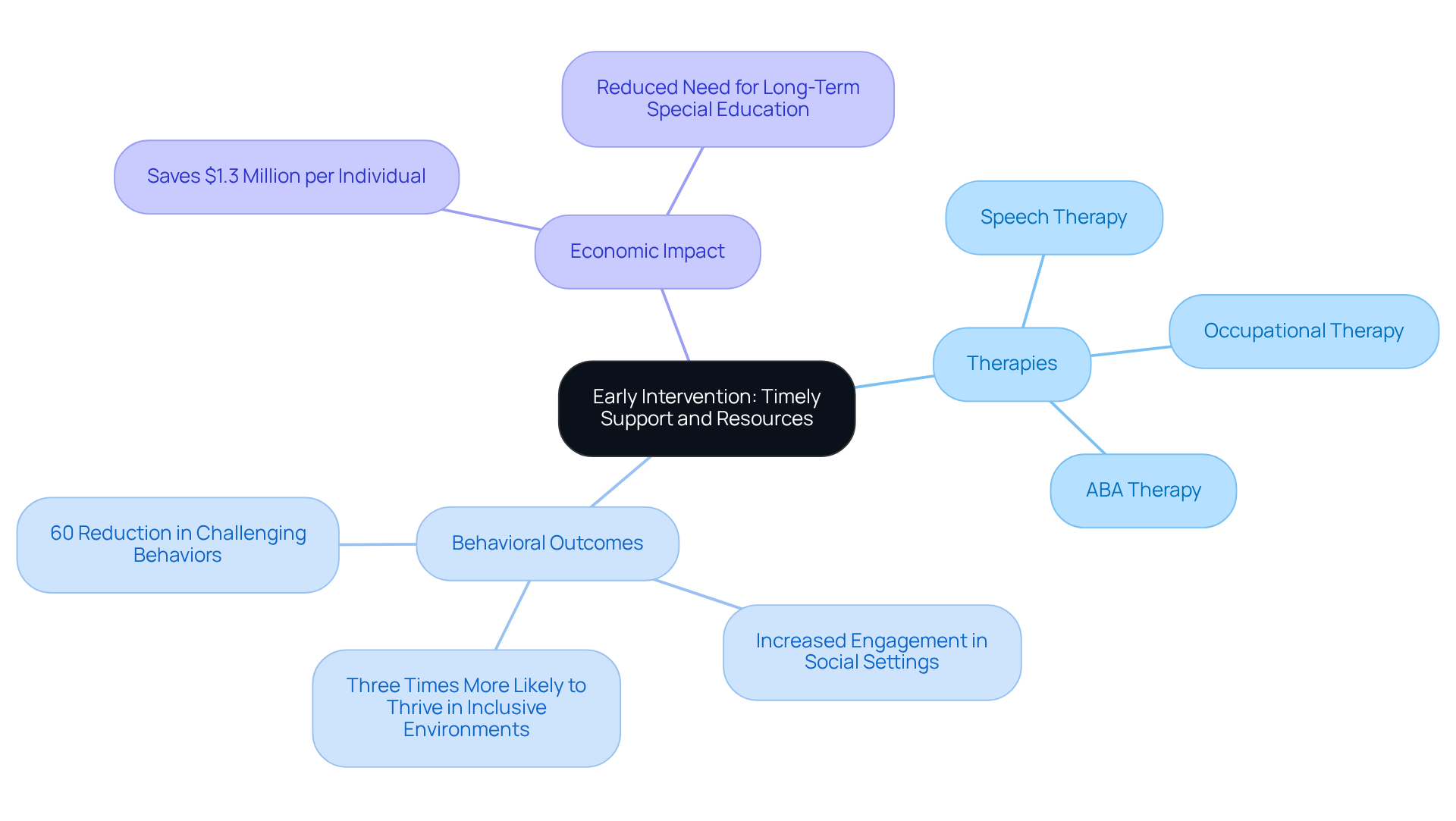
Conclusion
Recognizing the symptoms of PDD-NOS is essential for parents striving to provide the best support for their children. This article highlights key indicators, including:
- Challenges in social interaction
- Communication delays
- Repetitive behaviors
- Sensory sensitivities
- Emotional regulation issues
- Developmental delays
- The need for structured environments
By understanding these symptoms, parents can take proactive steps towards intervention, fostering an environment where their children can truly thrive.
The insights shared emphasize the importance of early recognition and intervention. By identifying symptoms such as:
- Difficulties in peer engagement
- Delayed speech
- Emotional dysregulation
Parents can seek appropriate therapies and support systems. Strategies like establishing routines, utilizing visual aids, and engaging in targeted therapies can significantly enhance a child's development and overall quality of life.
As the prevalence of autism continues to rise, it is crucial for parents to remain informed and empowered. By leveraging available resources and support networks, they can navigate the complexities of PDD-NOS effectively. Taking action early not only benefits the child’s developmental trajectory but also alleviates the long-term economic burdens associated with autism. Together, through awareness and timely intervention, we can achieve a brighter future for children with PDD-NOS.
Frequently Asked Questions
What is the mission of ASD Media?
ASD Media is committed to enhancing the implementation of ABA therapy and providing valuable insights and effective strategies to improve outcomes for children with autism and ADHD. Their mission is to cultivate a supportive and inclusive environment for sharing experiences and learning.
What resources does ASD Media offer?
ASD Media offers resources designed for both caregivers and professionals, focusing on managing challenging behaviors, navigating support services, and enhancing interpersonal skills development.
How can parents stay informed about autism awareness and resources?
Parents can subscribe to the ASD Media newsletter to stay informed about the latest news and gain unlimited digital access to a wealth of resources.
What challenges do children with PDD-NOS face in social interactions?
Children with PDD-NOS often struggle with making eye contact, misinterpreting interpersonal cues, and hesitating to initiate conversations, leading to feelings of isolation and frustration.
How prevalent are developmental disabilities among individuals with autism?
Research shows that around 83% of individuals with autism spectrum disorder (ASD), including those with PDD-NOS, experience co-occurring developmental disabilities, complicating interpersonal interactions.
What role does music therapy play in improving interpersonal skills?
Music therapy has shown promise in enhancing interpersonal skills among youth with ASD. Studies indicate that children participating in music therapy sessions demonstrated significant improvements in joint attention and communication abilities.
Why is early recognition of social interaction challenges important for parents?
Early recognition allows parents to take prompt action, which can lead to better outcomes for their children, helping them build meaningful connections with peers and improve their overall quality of life.
What are common communication delays associated with PDD-NOS symptoms?
Common delays include not babbling by the expected age, having a limited vocabulary, and exhibiting echolalia, where children repeat phrases without understanding their meaning.
What is the importance of early speech therapy for children with PDD-NOS?
Early speech therapy is crucial as it enhances communication skills, fosters social interactions, and supports overall development, leading to significantly improved outcomes.
What is the economic burden of raising a child with ASD?
The economic burden can range from $1.4 million to $2.4 million over a lifetime, highlighting the need for effective interventions and support for families.




